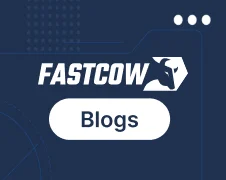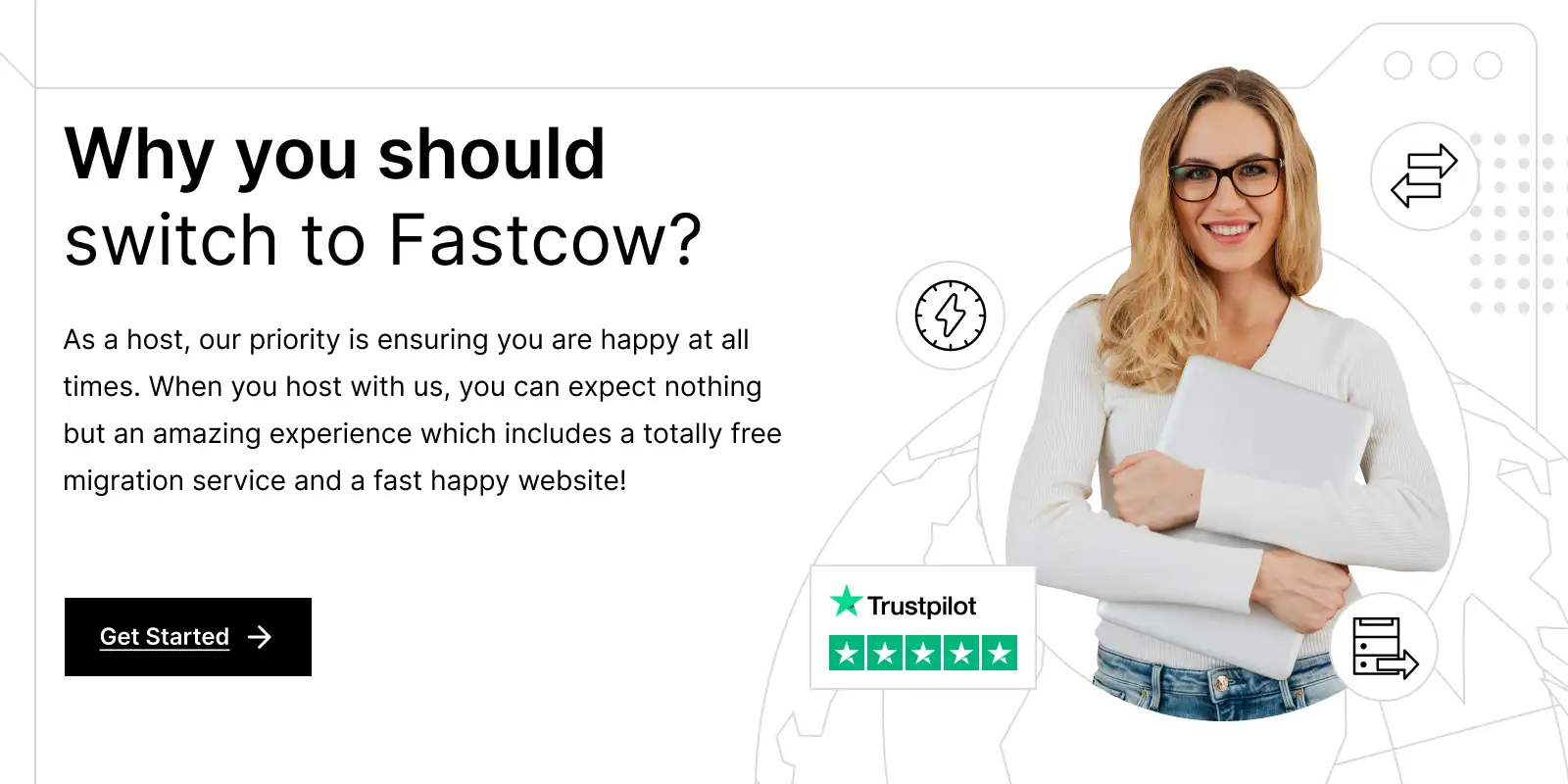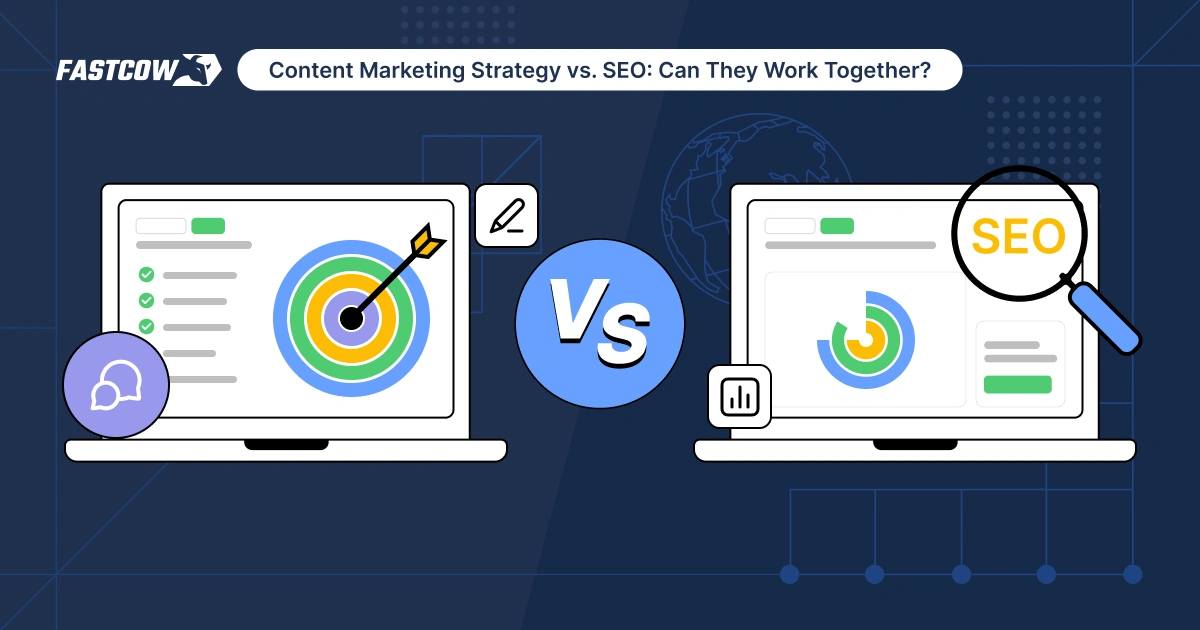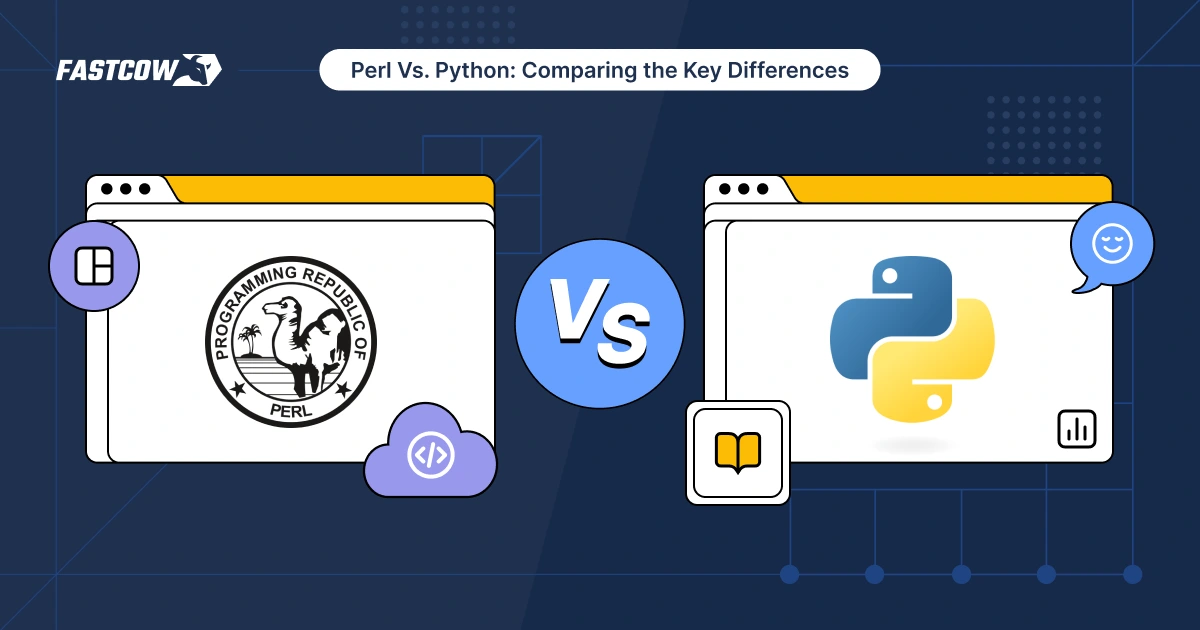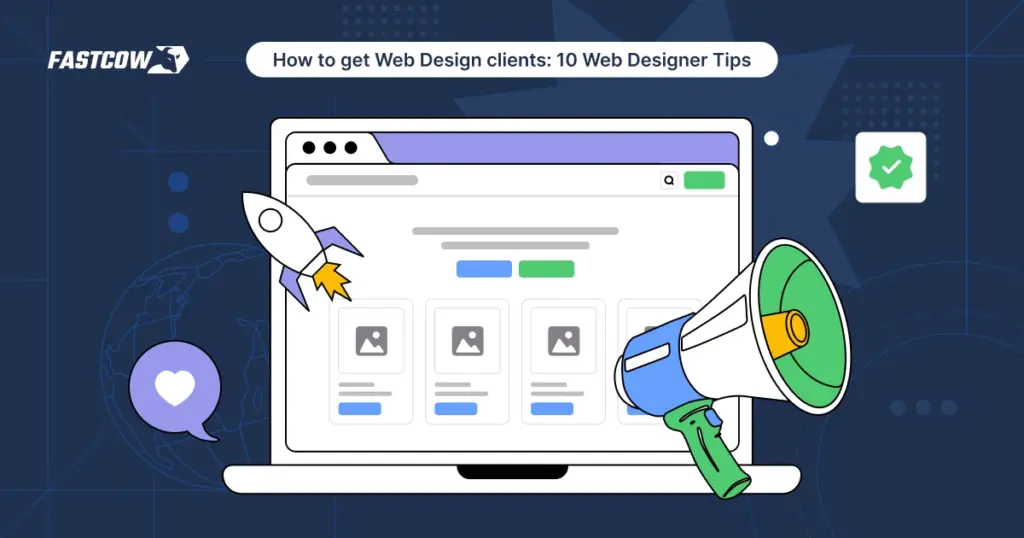
How do you get web design clients in 2025 without wasting time on outdated methods?
The game has changed. Many designers struggle because they rely on referrals, bidding sites, or cold emails that get ignored. These approaches make it hard to find high-paying clients and lead to unpredictable income.
Competition is stronger than ever. Clients expect more than a good portfolio. They want trust, speed, and results. Landing projects becomes a struggle if you don’t have a structured client acquisition system.
- 10 Steps to Land High-Paying Web Design Clients
- Identify Your Ideal Web Design Clients
- Optimize Your Website & Online Presence for Conversions
- Leverage AI-Powered Cold Outreach (Fastest Way to Get Clients in 30 Days)
- Dominate High-End Freelance Marketplaces (Without Competing on Price)
- Build an Inbound Lead Generation Machine (SEO + Content Marketing)
- Master LinkedIn Authority & Social Selling
- Use Paid Ads & Retargeting for High-Paying Clients
- Implement Referral Marketing & Partnerships for Consistent Clients
- Turn One-Time Clients Into Recurring Revenue (High-Ticket Retainers)
- Automate & Scale Your Web Design Business for Long-Term Growth
- 90-Day Web Design Client Roadmap (Step-by-Step Growth Plan)
- Final Thoughts
- FAQs
Our approach solves this. We combine AI-powered outreach, inbound content, and high-ticket positioning. This formula helps you attract, convert, and retain clients—without begging for work.
10 Steps to Land High-Paying Web Design Clients
You’ll learn a fast, scalable way to grow your web design business in the next ten steps. Whether you’re starting fresh or looking to break past income ceilings, this guide will show you how. Let’s build a system that brings clients to you.
Step 1: Identify Your Ideal Web Design Clients
Finding web design clients is easier when you focus on a specific market. A broad approach leads to price competition and low-quality leads. Choosing a niche lets you attract better clients, charge higher rates, and build a recognizable brand.
Why Niching Down Matters in 2025
More businesses need specialized websites. Generic design services struggle to stand out. Niching gives you authority, making it easier to attract clients willing to pay premium prices. The best niches include:
- SaaS – Startups launching software need optimized landing pages and user-focused designs.
- eCommerce – Online stores require high-converting layouts and seamless shopping experiences.
- Local Businesses – Law firms, realtors, and medical professionals need professional branding.
- Coaches & Consultants – Experts seek credibility-building websites to sell services.
Each market has unique challenges. Understanding them helps position your services effectively.
How to Choose a Profitable Niche
Picking the right niche means balancing passion, demand, and profit potential. Use this framework:
- Profitability – Are businesses in this space making money? If they invest in ads or content, they likely have a budget.
- Urgency – Do they urgently need a website? Startups, agencies, and growing businesses usually do.
- Competitor Analysis – Are other designers succeeding in this space? If yes, it’s a good sign.
- Expertise Fit – Do you understand their industry? If not, research will take longer.
Define Your Ideal Client Avatar
A vague target leads to wasted effort. Create a client profile based on:
- Industry (e.g., SaaS, healthcare, finance)
- Business size (solo, startup, established company)
- Budget (willing to invest $3K+ for web design)
- Main problem (low conversions, poor branding, outdated website)
- Decision-maker (founder, marketing head, business owner)
The clearer your ideal client, the easier it is to find them.
Where to Research High-Ticket Clients
Smart research saves time. Use tools that show real-time demand:
- Google Trends – See rising industries needing web design.
- LinkedIn – Find professionals launching businesses needing websites.
- Reddit & IndieHackers – Watch discussions where startups talk about design needs.
- Facebook Groups – Engage in industry-specific groups where business owners seek help.
Choosing the right clients is the foundation of a profitable web design business. Focus on the best market from the start.
Step 2: Optimize Your Website & Online Presence for Conversions

A strong online presence makes it easier to get web design clients fast. Your website should not just showcase work—it must convert visitors into leads.
Your Website = Your Sales Machine
A poorly structured site repels clients. A high-converting layout builds trust. Follow this structure:
- Clear Headline – State your value in one sentence. Example: “Helping SaaS Companies Increase Conversions with Custom Web Design.”
- Portfolio Section – Show results-driven projects, not just visuals. Add metrics like “Boosted Conversions by 35%.”
- Client Testimonials – Trust signals from past work help convert visitors.
- Simple Contact Form – Fewer fields = more leads. Name, email, and a short message are enough.
- Call-to-Action (CTA) – Guide visitors. Use “Book a Free Consultation” or “Get a Website Audit.”
SEO for Web Designers
Clients search for designers online. Ranking for the right terms gets you discovered. Optimize for:
- "how to get web design clients"
- "website design business"
- "build websites for clients"
- "[your city] web designer" for local SEO
Fast-loading, mobile-friendly pages boost rankings. Write helpful blog posts to attract inbound leads.
Lead Capture Systems
Not everyone hires immediately. Capture emails with:
- Free checklists or guides (e.g., “10 Mistakes Killing Your Website Conversions”).
- Free consultations—position them as strategy calls, not sales pitches.
- Email follow-ups to nurture leads over time.
Website Audit Playbook
Auditing client websites helps you stand out. Check:
- Speed & Mobile Optimization – Slow sites lose visitors.
- User Experience (UX) Issues – Confusing layouts hurt conversions.
- SEO & Content – Poor headlines or missing keywords reduce traffic.
Offer free audits to hook potential clients. Show them what’s broken and how you can fix it. Keeping a site optimized is key—use this WordPress Maintenance Checklist to ensure every website you build runs smoothly. Your website should work for you 24/7. Set it up right, and clients will come to you.
Step 3: Leverage AI-Powered Cold Outreach (Fastest Way to Get Clients in 30 Days)
Cold outreach works if done right. AI tools make it scalable and effective. Automate tasks, personalize messages and connect with ideal clients fast.
AI-Powered Outreach Tools
Manual prospecting wastes time. AI handles research, personalization, and follow-ups. Use:
- Instantly.ai – Automates email outreach with warm-up features.
- Clay – Scrapes prospect data and enriches email personalization.
- Saleshandy – Tracks email opens, automates sequences, and manages follow-ups.
Set up campaigns, refine messaging, and let AI find potential leads.
Cold Email Framework That Converts
Your message must be short, clear, and valuable. Follow this format:
Subject: Quick Idea for [Client’s Business Name]
Email Body:
- Personalized Opener – Mention something specific about their website or business.
- Problem Statement – Highlight an issue hurting their conversions.
- Solution – Show how your web design service solves that issue.
- Call-to-Action (CTA) – Ask a simple yes/no question (e.g., “Would you like a quick 10-minute chat?”).
Keep it under 100 words. Follow up 2-3 times if no response.
LinkedIn Sales Navigator Playbook
Clients check LinkedIn daily. Use these steps:
- Target Decision Makers – Filter by industry, company size, and role.
- Engage Before Messaging – Like posts, comment, and build familiarity.
- DM Strategy – Avoid generic pitches. Start with a compliment or insightful question.
AI tools like Taplio automate post scheduling, keeping you visible.
Loom Video Outreach Strategy
Videos grab attention. A short audit video shows expertise fast. Steps:
- Visit the client’s website.
- Record a 1-2 min Loom video highlighting 2-3 issues.
- Offer a quick call to discuss solutions.
Personalized videos get higher response rates than text-based cold outreach.
AI speeds up outreach, but personalization wins clients. Use both, and you’ll fill your pipeline fast.
Step 4: Dominate High-End Freelance Marketplaces (Without Competing on Price)
Freelance marketplaces are crowded. Low-cost platforms force price wars. High-end platforms attract serious clients who value quality. Target premium sites and position yourself for bigger projects.
Why Fiverr & Upwork Won’t Get You Premium Clients
Race-to-the-bottom pricing kills profitability. Competition is high, and buyers expect cheap work. High-paying businesses avoid these platforms. Instead, they seek experts on exclusive marketplaces.
Best High-End Freelance Platforms
Join platforms that filter for top talent. These options connect you with businesses willing to invest in quality web design:
- Toptal – Curates the top 3% of freelancers. High earnings, but rigorous screening.
- Braintrust – Focuses on tech talent with transparent pricing.
- Credo – Matches clients with vetted designers and developers.
- Clarity – Lets you charge per-minute for expert consultations.
- Fastcow– Specializes in premium Managed WordPress Hosting.
- SiteAim – Fixes WordPress bugs quickly to keep your site running smoothly.
Profiles on these platforms attract well-funded businesses looking for top-tier work.
How to Stand Out with Premium Proposals & Video Pitches
A strong proposal gets attention. Make yours clear, personalized, and value-driven:
- Subject Line: Highlight a quick win for the client.
- Opener: Show understanding of their needs.
- Solution: Outline a custom strategy based on their goals.
- Call to Action: Offer a free consultation or website audit.
A video pitch makes proposals even stronger. Use Loom to record a short intro explaining how you can improve their online presence.
Building Long-Term Relationships, Not Just One-Time Projects
Clients return when they trust you. Focus on:
- Delivering results, not just designs. Show how your work increases conversions.
- Providing post-launch support. Offer maintenance plans.
- Upselling additional services. Suggest ongoing SEO, CRO, or redesign updates.
High-end clients value expertise. Position yourself as a trusted partner, not a one-time service provider.
Step 5: Build an Inbound Lead Generation Machine (SEO + Content Marketing)
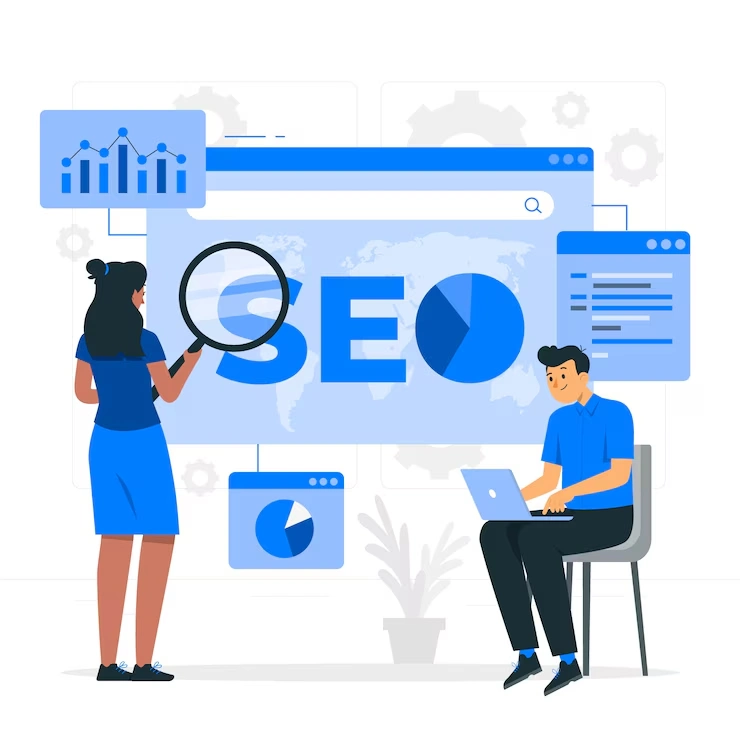
Inbound leads bring clients to you. No chasing. No cold emails. Just high-quality prospects ready to invest in web design. To attract them, build a content engine that ranks on search engines and gets attention on social media.
How to Create Content That Attracts Web Design Clients
Content must answer real business problems. A structured content matrix helps balance variety and consistency:
- Educational: Web design tips, trends, and strategies.
- Problem-solving: Case studies, redesign success stories, and before/after analyses.
- Engagement-driven: Polls, interactive quizzes, and user-generated content.
- Authority-building: Guest posts, expert interviews, and collaborations.
Long-Form vs. Short-Form Content (What Works Best?)
Both formats serve different roles:
- Long-form (1,500+ words): Best for blog posts and YouTube deep dives. Optimized for SEO, driving organic leads over time.
- Short-form (15-60 sec): Best for TikTok, Instagram Reels, and YouTube Shorts. Generates quick engagement and boosts visibility.
A mix of both ensures maximum reach.
Optimizing Blog Posts for SEO & Social Media Exposure
Every post should target high-intent keywords. Structure matters:
- Title: Include client-focused phrases like “How to Improve Website Conversions.”
- Headings: Break content into digestible sections for readability.
- Keywords: Naturally integrate search terms (without stuffing).
- Internal Links: Guide readers to relevant content on your site.
- Call to Action: Offer free audits, resources, or consultations.
Leveraging TikTok, YouTube, and Instagram for Inbound Leads
Video content builds trust fast. Use these platforms strategically:
- TikTok & Instagram Reels: Share quick tips, showcase past work, and answer common client questions.
- YouTube: Publish detailed tutorials, case studies, and design walkthroughs.
- Live Q&A Sessions: Engage with potential clients in real time.
Inbound marketing compounds over time. The more helpful content you publish, the more ideal clients find you—without paid ads or cold outreach.
Leverage smart tools to streamline your efforts—check out the 10 Best WordPress AI Plugins to Use in 2025 to automate content creation and optimize engagement.
Step 6: Master LinkedIn Authority & Social Selling
LinkedIn is a goldmine for high-paying web design clients. Business owners, decision-makers, and marketing teams actively seek design services there. The right strategy turns your profile into a lead magnet.
How to Turn Your LinkedIn Profile Into a Client Magnet
Your profile must attract, not repel. Optimize these key areas:
- Headline: Show your expertise in one sentence. Example: “Helping SaaS brands boost conversions with high-performance web design.”
- About Section: Speak directly to client pain points. Include results, case studies, and a call to action.
- Featured Section: Showcase past projects, testimonials, and a link to book a consultation.
- Experience & Skills: List relevant work history and endorsements to build credibility.
The 3-Step LinkedIn Content Strategy
- Engagement: Comment on relevant posts daily. Add insights, not generic praise.
- Credibility: Share lessons from past projects, industry trends, or client success stories.
- Lead Generation: Offer free audits, website teardowns, or guides in exchange for DMs.
Best LinkedIn Post Frameworks That Generate Inbound DMs
- The “Pain-Point” Post: Highlight a common problem (e.g., slow-loading websites) and provide a quick fix.
- The “Before & After” Post: Showcase a site transformation and the impact on conversions.
- The “Personal Journey” Post: Share your web design journey, wins, and struggles to connect with prospects.
- The “Value Drop” Post: Offer actionable tips or checklists that business owners can apply.
Social Media Networking Beyond LinkedIn
- Facebook Groups: Engage in niche business groups and offer design insights.
- X (Twitter): Follow industry leaders, join discussions, and post short-form web design tips.
- Reddit: Answer questions in r/web_design and r/entrepreneur with genuine value.
Consistent social selling builds trust. The more visible you are, the more likely clients reach out.
Step 7: Use Paid Ads & Retargeting for High-Paying Clients
Paid ads offer a shortcut to high-ticket web design clients. Instead of waiting for inbound leads, you put your services in front of businesses actively looking for website solutions. With the right targeting, paid campaigns generate quality leads fast.
When & How to Use Google Ads, LinkedIn Ads, and Facebook Retargeting
- Google Ads: Target search queries like “website redesign for eCommerce” or “hire a web designer.” Businesses searching these terms need immediate solutions.
- LinkedIn Ads: Reach decision-makers at SaaS companies, law firms, or agencies. Run lead-gen ads offering free website audits or consultations.
- Facebook Retargeting: Retarget site visitors, video viewers, and ad engagers with reminders about your services.
Running Lead-Gen Ads for Website Redesigns
- Offer a Freebie: A “Website Performance Audit” or “Homepage UX Analysis” entices businesses to submit their details.
- Target the Right Audience: Use industry, job title, and company size filters for precision.
- Use Persuasive Copy: Highlight speed, design, and conversion-focused benefits, not just aesthetics.
Retargeting Strategies That Convert Warm Leads
Most prospects won’t hire after seeing one ad. Retargeting keeps you top of mind.
- Website Visitors: Show them testimonials, portfolio highlights, or a limited-time offer.
- Abandoned Forms: If someone starts but doesn’t finish a lead form, retarget with a reminder.
- Video Viewers: People who watch 50%+ of your ad are interested. Send them a follow-up ad with a strong CTA.
How to Create High-Converting Landing Pages for Paid Traffic
A weak landing page kills ad performance. Every element should push visitors to take action.
- Clear Headline: “Boost Conversions with a High-Performance Website.”
- Compelling Offer: Free consultation, audit, or case study download.
- Social Proof: Show logos, testimonials, and past results.
- Strong CTA: “Book Your Free Audit” or “Get a Custom Website Plan.”
Paid ads work best when combined with retargeting. A well-structured campaign turns clicks into high-paying clients.
Step 8: Implement Referral Marketing & Partnerships for Consistent Clients
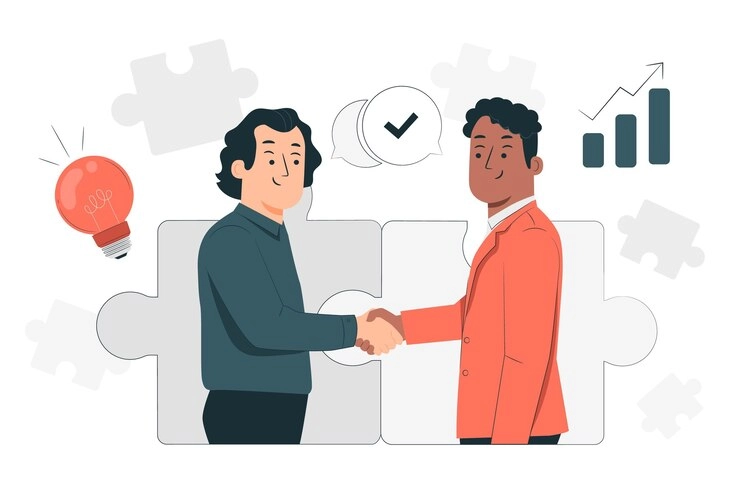
Referrals and partnerships bring steady, high-value web design clients. Instead of chasing leads, you let past clients and strategic partners send business your way. A well-built system makes this process effortless.
The Secret to Getting Referrals That Actually Bring in Business
Most web designers rely on word-of-mouth but don’t structure it. Make referrals intentional.
- Ask at the Right Time: Clients happy with your work are more likely to refer. Request introductions right after a successful project.
- Make It Easy: Provide a simple referral message they can copy and send.
- Offer an Incentive: A small discount on future work or a commission can motivate clients to refer.
Partnering With Marketing Agencies, SaaS Founders, and Tech Startups
Collaboration with complementary businesses creates a win-win situation.
- Marketing Agencies: Agencies need designers for their client projects. Offer white-label services or a commission structure.
- SaaS Founders: Fast-growing software companies need UX/UI improvements and landing pages. Position yourself as their go-to designer.
- Tech Startups: New startups often lack in-house design talent. Build relationships early for long-term contracts.
How to Create a Client Referral System That Runs on Autopilot
A structured system turns referrals into a predictable lead source.
- Set Up an Official Program: Create a dedicated page explaining referral rewards.
- Use Email Sequences: Automate follow-ups asking past clients for introductions.
- Remind Consistently: Include a referral link in email signatures and project completion messages.
Joint Ventures & Co-Marketing Strategies (Win-Win Collaborations)
Leverage existing audiences by partnering with industry experts.
- Guest Webinars & Workshops: Teach business owners how great web design improves conversions.
- Co-Branded Lead Magnets: Create free guides or templates featuring your expertise and your partner’s services.
- Cross-Promotion: Promote each other’s services on LinkedIn, newsletters, and social media.
Referrals and partnerships reduce client acquisition costs while building trust-based connections. A strong system keeps work flowing without constant prospecting.
To scale efficiently, you need reliable infrastructure—here are 10 reasons to choose an agency-focused hosting platform that supports growth without technical headaches.
Step 9: Turn One-Time Clients Into Recurring Revenue (High-Ticket Retainers)
Securing new clients takes effort. Keeping existing ones is easier and more profitable. Instead of relying on one-off projects, shift to long-term relationships that generate predictable income.
The Shift From One-Off Projects → Long-Term Contracts
Most web designers finish a project and move on. That leaves gaps in income. Instead, focus on building long-term value for clients.
- Businesses Need Ongoing Support: Websites require updates, security patches, and performance improvements.
- Clients Value Stability: A retainer ensures reliable web maintenance without the hassle of hiring different freelancers.
- Higher Lifetime Value: A single project might pay once, but recurring work compounds over time.
How to Package Your Services as a Subscription or Monthly Retainer
Position yourself as an ongoing partner rather than a one-time service provider.
- Offer Monthly Plans: Structure services like hosting, updates, and minor design tweaks into tiers.
- Solve Recurring Problems: Identify pain points businesses face regularly—SEO improvements, speed optimization, and security fixes.
- Charge for Priority Support: Provide a dedicated response time for clients who subscribe.
Creating Website Care Plans & Ongoing Maintenance Offers
A well-maintained website runs better and lasts longer. Business owners will pay for peace of mind.
- Website Performance Monitoring: Track speed, uptime, and traffic.
- Security & Backups: Ensure protection from malware and data loss.
- Content Updates & SEO Tweaks: Keep sites fresh with regular improvements.
Client Upsell Strategies to Maximize Lifetime Value
Expanding services increases revenue without needing new clients.
- Upsell Redesigns: Offer improvements based on user behavior data.
- Add Conversion Optimization: Businesses always want more leads. Small tweaks to layouts and call-to-action buttons help.
- Expand Into Paid Ads & SEO: If a client invests in design, they may need marketing support too.
Long-term contracts bring stability to your web design business. Clients stay engaged, and income remains steady. A solid retainer model means less time searching for leads and more time scaling your work.
Step 10: Automate & Scale Your Web Design Business for Long-Term Growth
Once your client pipeline is consistent, focus on scaling. Growth comes from automation, delegation, and predictable systems. Instead of handling everything yourself, build a business that runs efficiently.
Systemizing Client Acquisition With AI Tools & Automation
Repetitive tasks slow down growth. Automate them.
- AI-Powered Outreach: Tools like Instantly.ai and Clay find and contact leads automatically.
- CRM & Email Sequences: Automate follow-ups with platforms like HubSpot or Saleshandy.
- Proposal & Invoice Systems: Use PandaDoc or HoneyBook to streamline client onboarding.
How to Hire a Team or Outsource for Higher Scalability
Growth demands support. You can’t do it all alone.
- Freelancers & Contractors: Hire for tasks like development, SEO, or copywriting.
- Virtual Assistants: Offload admin tasks like scheduling and client communication.
- Project Managers: If handling multiple clients, a PM keeps projects on track.
Building a Predictable Sales Funnel for Long-Term Client Flow
A steady flow of leads means stability. Structure a system that attracts clients without constant effort.
- Website & SEO: Optimize pages to rank for searches like “how to get web design clients fast.”
- Paid Ads & Retargeting: Keep prospects engaged with Facebook or LinkedIn ads.
- Content Marketing: Use blogs, YouTube, and LinkedIn posts to build credibility.
Exit Strategies & Scaling Beyond Freelance Work
Scaling means shifting from freelancer to business owner. Options include:
- Productizing Services: Offer fixed-price web design packages.
- Launching a Web Design Agency: Hire full-time employees and expand services.
- Selling the Business: With solid revenue, your agency can be acquired.
A business that scales runs without daily micromanagement. The goal is freedom—more income, fewer hours, and a sustainable future.
The right hosting plays a key role in this, ensuring reliability and performance without constant oversight. Explore the different types of hosting to find the best fit for your growing web design business.
Summary Table: 10 Steps to Get Web Design Clients in 2025
| Step | Key Focus | Actionable Takeaways |
| 1. Identify Ideal Clients | Choose a profitable niche | Target high-paying industries (SaaS, eCommerce, local businesses). Use Google Trends & LinkedIn for research. |
| 2. Optimize Website & Online Presence | Convert visitors into leads | Use a high-converting structure, SEO, and lead magnets (free guides, audits). |
| 3. AI-Powered Cold Outreach | Automate lead generation | Use tools like Instantly.ai, personalize cold emails, and send Loom video audits. |
| 4. Dominate High-End Marketplaces | Avoid low-paying platforms | Focus on Toptal, Credo, and Codeable. Use video proposals to stand out. |
| 5. Build an Inbound Lead Machine | Attract clients via content | Use SEO-optimized blogs, YouTube, and social media for authority and organic leads. |
| 6. Master LinkedIn & Social Selling | Get inbound clients via networking | Optimize LinkedIn profile, post engaging content, and use strategic DMs. |
| 7. Paid Ads & Retargeting | Scale client acquisition | Use Google & LinkedIn Ads, retarget website visitors, and build landing pages. |
| 8. Referral Marketing & Partnerships | Get consistent inbound leads | Partner with agencies, SaaS founders, and offer referral incentives. |
| 9. Recurring Revenue Model | Secure long-term income | Sell monthly retainers (website maintenance, SEO, updates) instead of one-time projects. |
| 10. Automate & Scale | Systemize and grow | Use AI for lead generation, outsource work, and scale into an agency or sell the business. |
90-Day Web Design Client Roadmap (Step-by-Step Growth Plan)
A structured approach helps you build momentum, land clients, and scale your web design business. Follow this 90-day roadmap to consistently attract high-paying clients.
First 30 Days: Cold Outreach, AI Automation, LinkedIn Networking
This phase focuses on direct outreach and relationship-building to land your first clients fast.
1. Automate Cold Outreach
- Use Instantly.ai, Saleshandy, or Clay to automate personalized cold emails.
- Target businesses needing website redesigns (eCommerce, SaaS, startups).
- Offer free mini audits or consultations in emails to get responses.
2. Optimize Your LinkedIn for Lead Generation
- Update your headline & bio to position yourself as a web design expert.
- Post valuable insights on website optimization, SEO, and UI/UX trends.
- Connect with marketing managers, founders, and tech leads in your niche.
- Use LinkedIn Sales Navigator to send targeted DMs.
3. Send Personalized Video Audits
- Record Loom videos reviewing potential clients' websites.
- Highlight conversion issues, SEO gaps, and design flaws.
- End with a clear CTA (e.g., “Let’s book a quick call to fix this”).
30-60 Days: SEO-Driven Content, Social Proof, Guest Posts & Partnerships
Now that you have initial traction, focus on building authority and attracting inbound leads.
4. Create SEO-Optimized Content
- Write long-form blog posts targeting phrases like “best web design trends” and “how to improve website conversions”.
- Share case studies on before-and-after website redesigns.
- Repurpose content into TikTok clips, LinkedIn posts, and Instagram carousels.
5. Leverage Social Proof & Testimonials
- Ask first clients for video testimonials or LinkedIn recommendations.
- Feature before-and-after website transformations on your portfolio.
- Share client success stories in short LinkedIn or Twitter (X) posts.
6. Partner with Agencies & SaaS Companies
- Reach out to marketing agencies and offer white-label web design services.
- Collaborate with SaaS businesses that need website improvements.
- Join freelance networks like Toptal or Credo for premium clients.
A well-optimized hosting setup can boost your SEO, helping more clients find you organically. Learn how hosting impacts SEO and make your website a powerful lead magnet.
Beyond 90 Days: Scaling Through Referrals, Paid Ads, and Retainer Models
With a steady client flow, scale up your business and increase recurring revenue.
7. Automate Referral Marketing
- Offer incentives for past clients to refer new business.
- Build an email list and nurture relationships with monthly updates & offers.
- Join co-marketing campaigns with complementary service providers.
8. Launch Targeted Paid Ads
- Run Google Ads for businesses searching for website design services.
- Use Facebook retargeting for visitors who checked your site but didn’t convert.
- Test LinkedIn Ads targeting decision-makers in growing companies.
9. Convert Clients Into Long-Term Contracts
- Sell website maintenance retainers (monthly updates, security, and SEO fixes).
- Offer subscription-based packages (ongoing design tweaks, CRO improvements).
- Upsell additional services like branding, SEO, or marketing automation.
10. Systemize & Scale
- Document your client acquisition process and automate lead nurturing.
- Hire a team of designers or outsource tasks to scale revenue.
- Explore exit strategies like selling your agency or transitioning to coaching.
Final Thoughts
Finding web design clients in 2025 requires a smarter approach. Outdated tactics no longer work. You need AI-powered outreach, inbound content, and a strong referral network.
First, automate client acquisition with cold emails, LinkedIn networking, and video audits. Next, build authority with SEO-driven content, partnerships, and social proof. Finally, scale with paid ads, retainer models, and systemized workflows.
A reliable online presence is key to closing deals and delivering top-tier websites. Power your projects with FastCow Managed WordPress Hosting for speed, security, and seamless performance.
FAQs
Q. Is it hard to get web design clients?
It depends on your approach. If you rely on outdated methods like bidding wars, it can be tough. Instead, focus on AI-powered outreach, social proof, and inbound content. A strong personal brand and strategic networking will help you attract quality clients consistently.
Q. How I got my first web design client?
Start with your existing network. Reach out to friends, local businesses, and past colleagues. Offer value first, like a free website audit or a small redesign suggestion. Cold outreach, freelance platforms, and LinkedIn networking also work well for landing your first client.
Q. How do web design agencies get clients?
Agencies mix outbound and inbound strategies. They use cold email, LinkedIn, and video audits for outreach. SEO, content marketing, paid ads, and partnerships help attract clients organically. High-end agencies also focus on referrals and long-term contracts to secure recurring revenue.
Q. How to find people who need web design?
Look where businesses ask for help—LinkedIn, Reddit, and Facebook groups. Search job boards and freelance sites. Reach out to companies with outdated websites. Use paid ads targeting business owners needing redesigns. Cold emails and networking events also work well.
Q. What is the average cost to hire a Web Designer?
Costs vary by experience and project scope. Freelancers charge $50–$5,000+ for websites. Agencies start at $500 and go up to $50,000+ for complex sites. High-end designers working with SaaS or eCommerce brands charge premium rates for ongoing services.













